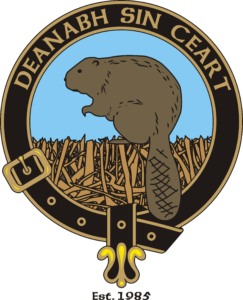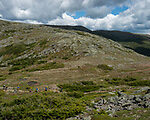Mizpah-Crawford Path Trip Report 8-19
By Scott MacFaden
CVHTC Board Member and Keeper of the Cuaich
On an oppressively hot and humid afternoon in late August, three members of the Cardigan Highlanders Volunteer Trail Crew –Craig Sanborn, Bruce James, and I, arrived at the Crawford Path trailhead on Mt. Clinton Road to begin our three-day adventure on the Crawford Path. Under the banner of the White Mountain Trail Collective, we were one of over a dozen entities that had been enlisted this trailwork season and last to help undertake a wide variety of projects to help improve sections of the Crawford Path, believed to be the oldest continuously used hiking trail in the country. Our primary task was to construct multiple “bog bridges” on a section of the Crawford Path a short distance below its junction with the northern end of the Webster Cliff Trail.
Although our trail crew’s primary “turf” encompasses Mt. Cardigan, Sunapee, and Kearsarge in southwestern New Hampshire, occasionally we branch out to other destinations in the state, and for the past two years we have enjoyed the opportunity to help out with the ongoing effort to maintain (and in some cases, rehabilitate) sections of the historic Crawford Path. Over a dozen trail maintenance groups large and small have participated in this comprehensive effort, from large groups like the AMC to small groups like us.
Apart from my participation with the Highlanders, I am the long-time adopter of the Franconia Brook Trail in the Pemigewasset Wilderness, and so I am no stranger to trail work in the White Mountains. However, the Crawford Path work trips have offered an intriguing and unusual opportunity to work on trails in a different section of the White Mountains, and in areas at or near treeline. Last year our work assignment took us to an area near the junction of the Crawford Path and Edmunds Path, where we were tasked with “brushing” sections of the trail that needed it, and blocking off unauthorized “bootleg” trails that unfortunately have trampled and destroyed sensitive alpine vegetation.
After conferring with our Forest Service contact Eric Samia, assembling the tools we would need for our work, and making a last-minute check of our equipment, we shouldered our packs and headed up the Crawford Path toward the AMC’s Mizpah Hut, our home for the next several days. The day’s heat and maximum humidity enforced upon us a deliberate pace as we ascended, with frequent water breaks. Fortunately, the thunderstorms we had been hoping would not materialize stayed away, and besides we weren’t in any particular hurry, with our only real imperative to ensure that we arrived at the hut shortly before 6 PM suppertime. If it’s one thing that all trail maintainers agree on, it’s that mealtime is sacrosanct, and never to be trifled with!
Safely arriving at the hut in advance of the cherished suppertime, we settled into our bunkroom, laid out our bedrolls, and strategized about the next day’s work plan. Then it was off to supper! Following the usual abundant and satisfying meal and dessert (some long-ago wit suggested that AMC is an acronym for “Another Meal Coming”), it was time to relax and await the cooler air and clearer skies that were on the way.
If I had any pretensions of sleeping in until shortly before breakfast was served at 7, they were dashed by one of the hut crew, whose angelic singing voice announced that it was 6:30, and breakfast was looming. No need for an alarm clock in the huts, although to be sure there was plenty of activity well before the 6:30 call that rendered sleep difficult for us light sleepers.
After a typically filling hut breakfast, we finished our packs and headed up the steep climb just in back of the hut. The Webster Cliff Trail climbs quite steeply for a short distance over sections of ledge and angular rock before leveling off as it approaches Mt. Pierce. Once upon its summit, we were treated to stunning views of much of the Presidential Range, including Mt. Eisenhower and Mt. Washington. One simply couldn’t ask for a better late-summer day—not a cloud to be seen, no haze to speak of, moderate temperatures and winds, and not a trace of that blasted humidity that we had cursed with such gusto the day before.
Arriving at our work site, our assignment was to build bog bridges on a section of the Crawford Path a short distance below its junction with northern end of the Webster Cliff Trail. The section of trail needing the bog bridges retains snow well into spring most years, and as a result is typically wet and muddy in the late spring/early summer hiking season. The purpose of the bog bridges is to help hikers stay above the wet and muddy areas, and ensure that the trail doesn’t transition into a seasonal mud pit.
Bog bridges are a relatively simple and inexpensive solution to the challenge of elevating hiker traffic above wet or seasonally wet areas. Not bridges in the truest sense, they are instead simple structures generally comprised of two equally sized wooden planks that are affixed to sills dug into the trail treadway. The planks are usually cedar or hemlock, and the sills are short sections of whole cedar logs that provide the foundation for the bridges. The Forest Service, for whom we were building the bog bridges, thankfully delivered the lumber for the bridges via helicopter before we arrived.
Despite their relative simplicity, constructing each bridge often takes more time than one might expect. The sills need to be dug in to the appropriate depth and leveled to the extent possible, notches need to be carved out of the top of the sills, and the planks need to align property with each other and the sills. Because all three of us had somehow forgotten to bring a chisel, we used an axe to create the notches in the sills.
As we toiled away, a steady stream of hikers trod past on their way to various points of interest, including nearby Mt. Pierce and Mt. Eisenhower. At one juncture we were fortunate to encounter a White Mountain dignitary—Laura Waterman, who with her friends John and Hannah were taking advantage of the spectacular late summer day to enjoy the view from Mt. Pierce.
Along with her late husband Guy, Laura made enormous contributions to the lore and scholarship of the White Mountains through their series of books, including their magnum opus, Forest and Crag. The Watermans also were trail adopters of some note, expertly maintaining the Franconia Ridge Trail for many years, and helping to educate hikers about the importance of respecting the fragile ecosystem of the alpine zone.
As is typical in my experience, most (98%) of the hikers with whom we interacted expressed gratitude for our trail maintenance efforts. It’s always nice to have some positive reinforcement. Of that remaining two percent, the first one percent appear bemused or befuddled (or perhaps both) that anyone would willingly carry heavy tools up a mountain to get dirty and suffer the attacks of voracious black flies and mosquitos. Many in this group ask if we get paid, and at least on one occasion, a passerby inquired if we were inmates on a work release program. (They were kidding—I think). The final one percent usually march past, either engrossed in conversation with their friends or encased in silence, seemingly oblivious to anything but their destination. Peak bagging is, after all, serious business in this era of the “grid” and the numerous other lists that trail obsessives fret over.
As the time to wrap up our day’s work approached, we took stock of our efforts. We had unearthed and relocated one bog bridge that was already in place but had sunken into near-oblivion, scouted out proper locations for three new bog bridges, assembled and installed those three new bridges, and re-opened and cleaned a drain adjacent to one of the new bridges. Not bad for amateurs!
Before heading back to the hut, we took a short respite near the junction of the Crawford Path and Webster Cliff Trail, and this was the view on offer from that location:
Not a bad place to be!
Following our hearty evening meal and some good conversation (and a dram of Laphroiag—if you don’t know what that is, look it up) my CHVTC colleagues and most of the hut guests prepared for bedtime. As a confirmed night owl, I opted to stay up for a while and headed outside to view the cloudless evening sky. Undisturbed by artificial light, the moonless sky possessed a striking clarity that is simply not available in the suburban area where I live.
With an ominous forecast looming for Wednesday, we thought it best to pack up after breakfast and make our way down to the trailhead in advance of the anticipated deluge, stopping at various points of interest along the way, including Gibbs Falls, a spectacular series of falls that cascade down through well-worn crevices in the bedrock. We also stopped to ponder the remains of the old dam that apparently supplied water for the former Crawford House, one of the long-gone grand hotels that stood in the location of today’s AMC Highland Center.
After stowing the tools we had borrowed from the Forest Service and putting on a clean shirt (always a good thing when one is poised to re-enter “civilization”), we set off on Rt. 302 in search of a burger before going our separate ways. Our timing was impeccable, as but a minute or two down the road the skies opened.
Thanks to Craig and Bruce for their good companionship, to the AMC hut “croo” for their hospitality, to Eric Samia and the folks with the US Forest Service for their support, and to the White Mountain Trail Collective for including us in the Crawford Path project over the past two years. Any time in the White Mountains is time to be savored and considered well-spent, and we appreciate the opportunity to be a part of this grand effort to keep the Crawford Path in good stead as it enters its third century.

